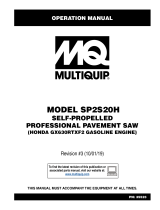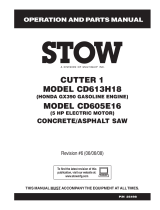
• Do not make modifications to this product.
• Do not operate the product if it is possible that other
persons have made modifications to the product.
Safety instructions for operation
WARNING: Read the warning
instructions that follow before you use the
product.
• Read the warning instructions that are supplied with
the cutting blade by the cutting blade manufacturer.
• Make sure that the product is assembled correctly.
• Do not operate the product without the blade guard
and the protective covers installed.
• Do not operate the product with the front of the blade
guard lifted or opened. The blade guard must be
lowered and correctly attached.
• Incorrect operation of the product can cause the
cutting blade to break and cause injury or damage.
• Make sure that you know how to stop the engine
quickly in an emergency.
• Use personal protective equipment. Refer to
Personal protective equipment on page 8
.
• Make sure that only approved persons are in the
work area.
• Make sure that electrical cables in the work area are
not live.
• Before you operate the product, find out if there are
hidden wires, cables and pipes in the work area.
If the product hits a hidden object, stop the engine
immediately and examine the product and the object.
Do not start to operate the product again until you
know that it is safe to continue.
• Do not use the product in bad weather conditions,
such as thick fog, heavy rain, strong wind or intense
cold. To do work in bad weather makes you tired
and can cause dangerous conditions, for example
slippery surfaces.
• Make sure that you are in a safe and stable position
during operation.
• The product can cause objects to eject at high
speed. Make sure that all persons in the work
area use approved personal protective equipment.
Remove loose objects from the work area.
• The exhaust fumes from the engine contain carbon
monoxide which is an odourless, poisonous and
very dangerous gas. Do not use a combustion
engine product indoors or in areas that do not have
sufficient airflow.
• Before you go away from the product, stop the
engine and make sure that there is no risk of
accidental start.
• If the product has parking brakes, do not go
away from the product without the parking brakes
engaged.
• Do not go away from the product when the engine is
started.
• Be very careful during operation on slopes. The
product is heavy and can cause serious injury if it
falls.
• Make sure that no material can become loose and
cause injury to the operator.
• Make sure that clothes, long hair and jewelry do not
get caught in moving parts.
• Do not operate the product unless you can get aid if
an accident occurs.
• Keep the work area clean and bright.
• Do not use the product in areas where fire or
explosions can occur.
Exhaust fumes safety
WARNING: Read the warning
instructions that follow before you use the
product.
• Long-term inhalation of exhaust fumes can cause
health problems.
• The exhaust fumes from the engine contain carbon
monoxide which is an odourless, poisonous and very
dangerous gas. To breathe carbon monoxide can
cause death. Because carbon monoxide is odourless
and cannot be seen, it is not possible to sense it. A
symptom of carbon monoxide poisoning is dizziness,
but it is possible that a person becomes unconscious
without warning if the quantity or concentration of
carbon monoxide is sufficient.
• Exhaust fumes that you can see or smell also
contain carbon monoxide.
• Do not use a combustion engine product indoors
and/or in areas that do not have sufficient airflow.
Vibration safety
WARNING: Read the warning
instructions that follow before you use the
product.
• During operation of the product, vibrations go from
the product to the operator. Regular and frequent
operation of the product can cause or increase the
degree of injuries to the operator. Injuries can occur
in fingers, hands, wrists, arms, shoulders, and/or
nerves and blood supply or other body parts. The
injuries can be debilitating and/or permanent, and
can increase gradually during weeks, months or
years. Possible injuries include damage to the blood
circulation system, the nervous system, joints, and
other body structures.
• Symptoms can occur during operation of the product
or at other times. If you have symptoms and
continue to operate the product, the symptoms can
increase or become permanent. If these or other
symptoms occur, get medical aid:
• Numbness, loss of feeling, tingling, pricking,
pain, burning, throbbing, stiffness, clumsiness,
1852 - 001 - 25.11.2022 7

























